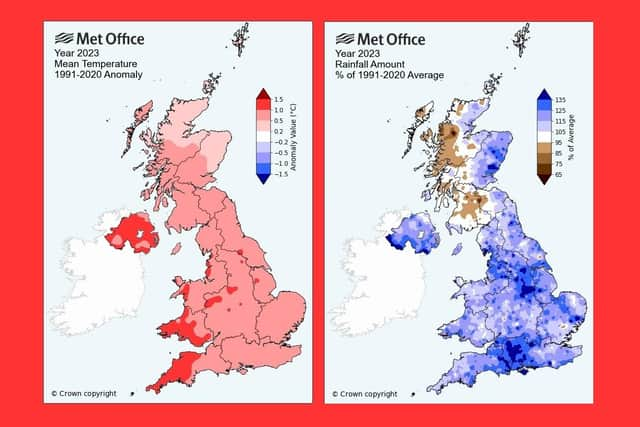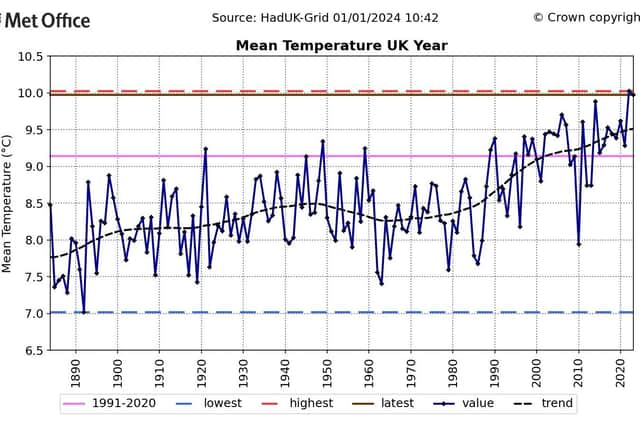Now it's official - 2023 was Northern Ireland's warmest year on record... and yet it had less sun and more rain
and live on Freeview channel 276
Not that this meant more sunshine: the numbers actually show fewer hours of sunshine than average, whilst it was one of the wettest years the Province has ever experienced.
The climate scientists at the agency are confident that this is part of an overall pattern linked to global warming.
Advertisement
Hide AdAdvertisement
Hide AdTheir figures for the whole of the UK show an unsteady but unmistakable upward trend in temperatures ever since it first began recording them.


The record-breaking warmth relates to Northern Ireland’s “mean temperature”: in other words, the average of all temperatures recorded across the whole Province during the entire 12 months of 2023.
• This shows that in 2023 the mean temperature across the Province was 10.17°C – which is the warmest since records began in 1884.
• It was some 1.04°C warmer than the 30-year average.
• Northern Ireland’s second warmest year was 2022, when the figure stood at 9.83°C.


Advertisement
Hide AdAdvertisement
Hide Ad• And the third warmest was 2007, when the number was 9.7°C.
• Looking at the daily highs and lows, Northern Ireland’s average daily high during 2023 stood at 13.69°C – which was some 1.02°C higher than the Province would normally expect, based on the 30-year average.
• Meanwhile the average daily low stood at 6.67°C – which was 1.06°C higher than the 30-year average.
• This did not translate into blue skies though: Northern Ireland only got 97% of the sunshine in 2023 that it would normally have expected when compared with the average over the preceding 30 year period.


Advertisement
Hide AdAdvertisement
Hide Ad• As for rainfall, during the whole of 2023, Northern Ireland got 1,399mm’s-worth, which is 21% more than it would normally have expected over the three decades previous.
• This was the wettest since 2002, and the third highest since the rainfall figures began going all the way back to 1836.
• But Northern Ireland was not being singled out – the picture is much the same across the whole UK.
• Spanning the entire nation, the 2023 UK mean temperature was 9.97°C, just behind 2022’s record-busting figure of 10.03°C.


Advertisement
Hide AdAdvertisement
Hide Ad• While most temperature figures only go back to the 1880s, for a section of central England the Met Office has data stretching back to 1659, and according to those records, 2023 was the second warmest year since then.
• The UK saw 11% more rain than the 30-year average (with 1289.8mm falling) and 2% more hours of sun (totalling 1,435.4).
Met Office Senior Scientist Mike Kendon said: “The observations of the UK climate are clear: climate change is influencing UK temperature records...
“We expect this pattern to continue as our climate continues to change in the coming years as a result of human-induced climate change.
Advertisement
Hide AdAdvertisement
Hide Ad"A warmer atmosphere has a greater capacity to hold moisture, so as our climate warms, we expect it to become wetter too... and that is also apparent in the observations.”
Met Office scientists have calculated that 2023’s average temperature would have been a one-in-500-year event without humans changing the climate through producing greenhouse gases.
But it is now a one-in-three-year event, and they believe that by the end of the century it could be happening almost every year.
The Met Office figures are provisional, to be confirmed later in 2024.
Advertisement
Hide AdAdvertisement
Hide AdIn a statement accompanying the figures yesterday, the agency said: ”The trend in UK climate observations is consistent with that observed globally – 2023 is on track to be Earth’s warmest year on record, while carbon dioxide concentrations in our atmosphere are at their highest for at least two million years.
“The five warmest years for the UK include 2020, 2022 and 2023 and the top 10 are all in the 21st century.
“Last year is almost certain to be confirmed as the hottest year ever recorded globally, with 2024 set to beat that again.”
At NASA, scientists use satellite and International Space Station data to monitor the concentrations of carbon dioxide (CO2), which is largely responsible for the greenhouse effect.
Advertisement
Hide AdAdvertisement
Hide AdIts most recent analysis in November found CO2 was present at a rate of 420 parts per million in the atmosphere.
In an accompanying statement, NASA said that “since the onset of industrial times in the 18th century, human activities have raised atmospheric CO2 by 50%… this human-induced rise is greater than the natural increase observed at the end of the last ice age 20,000 years ago”.